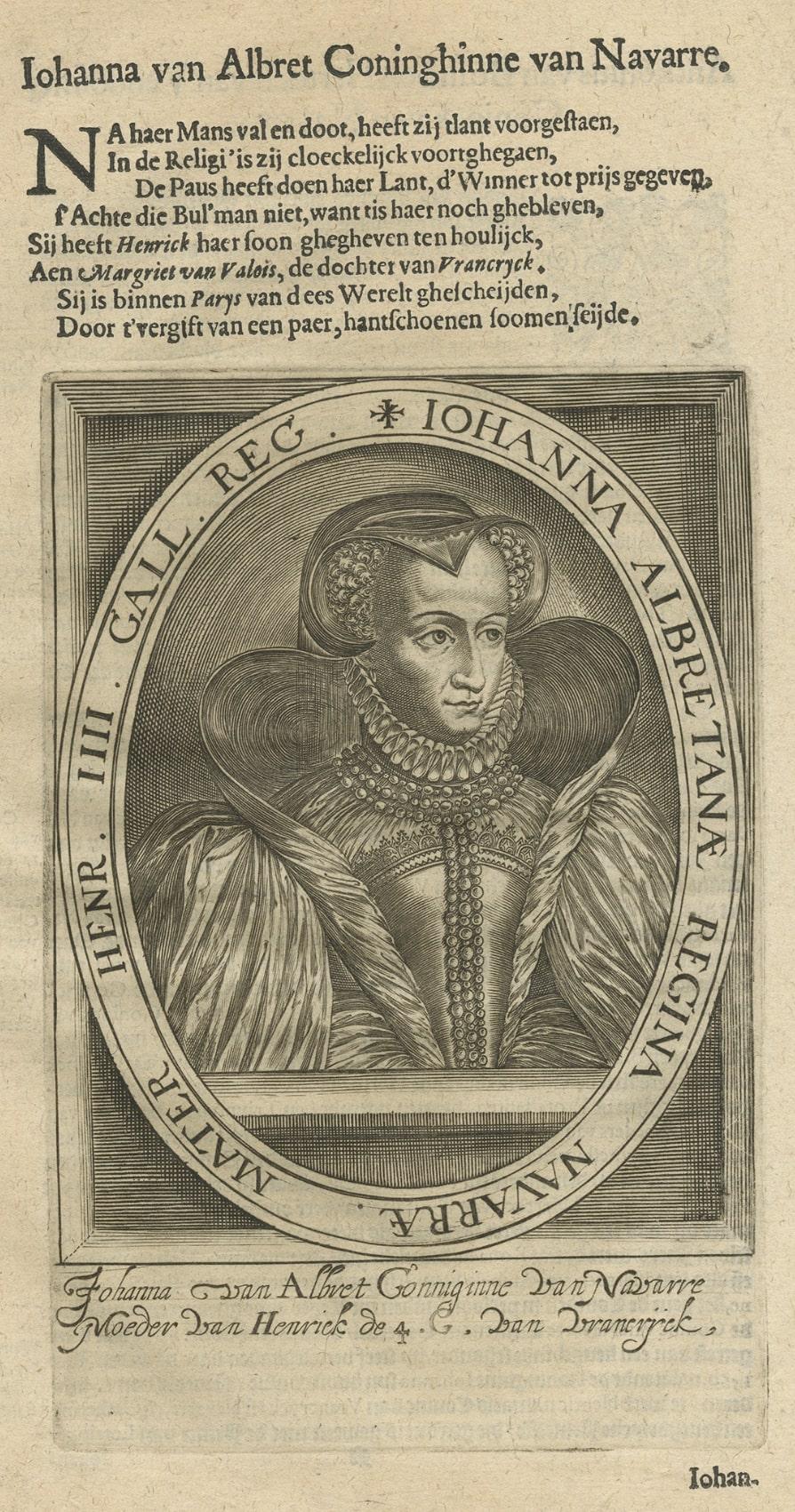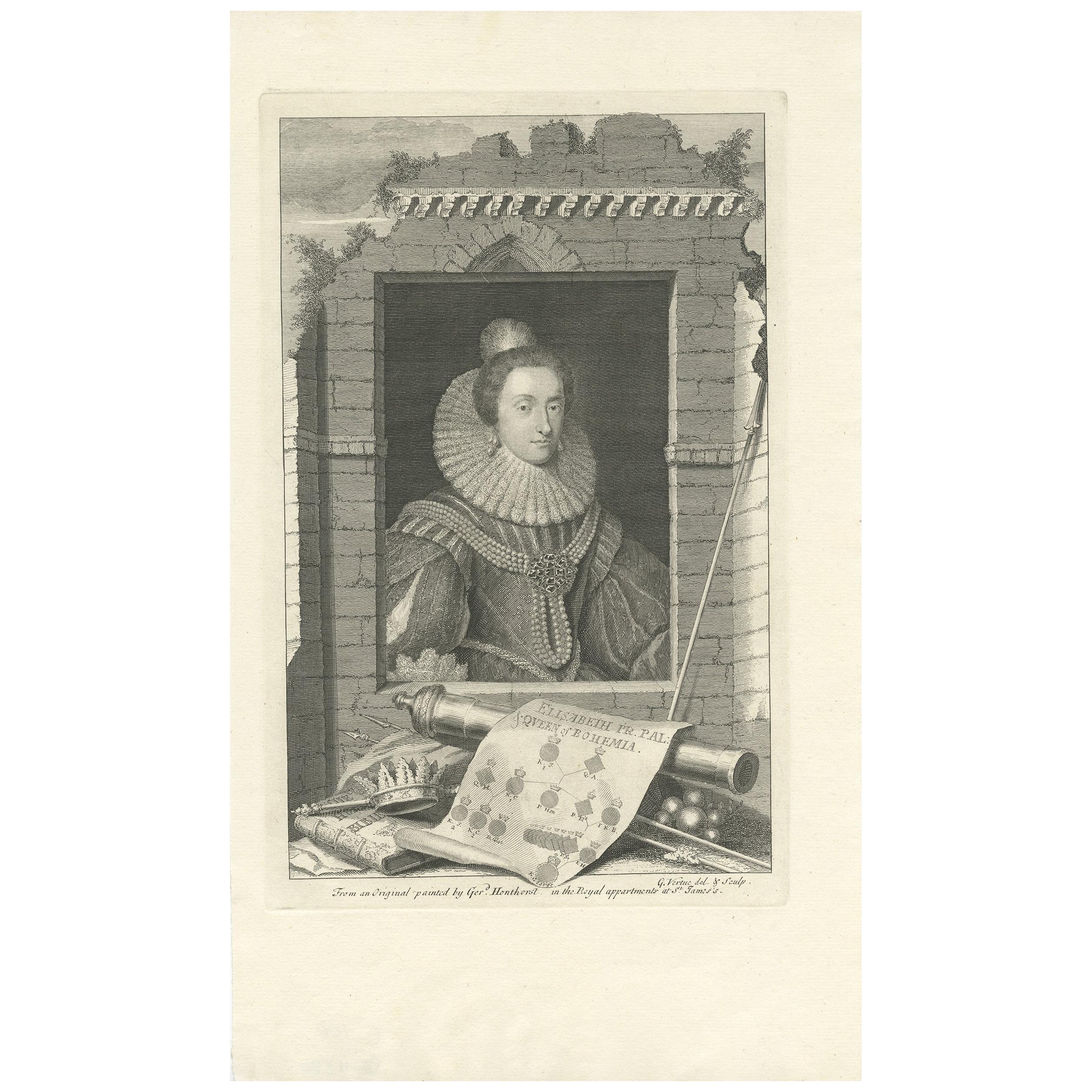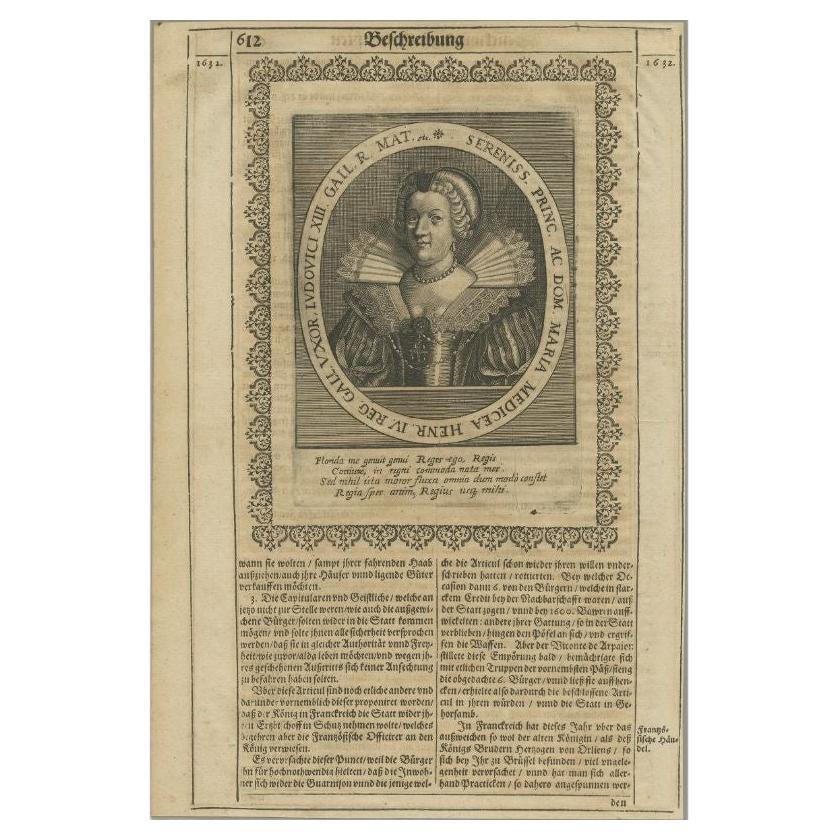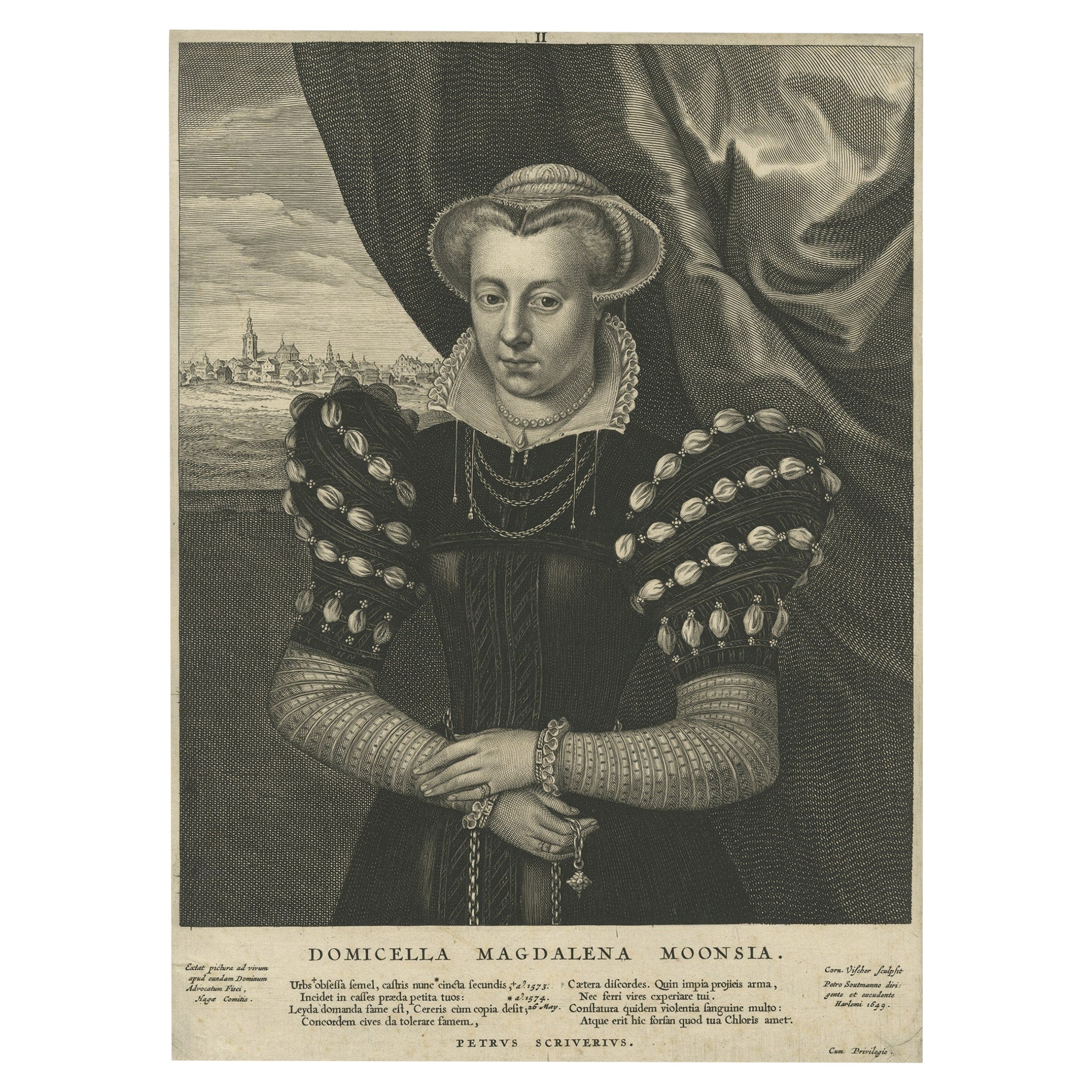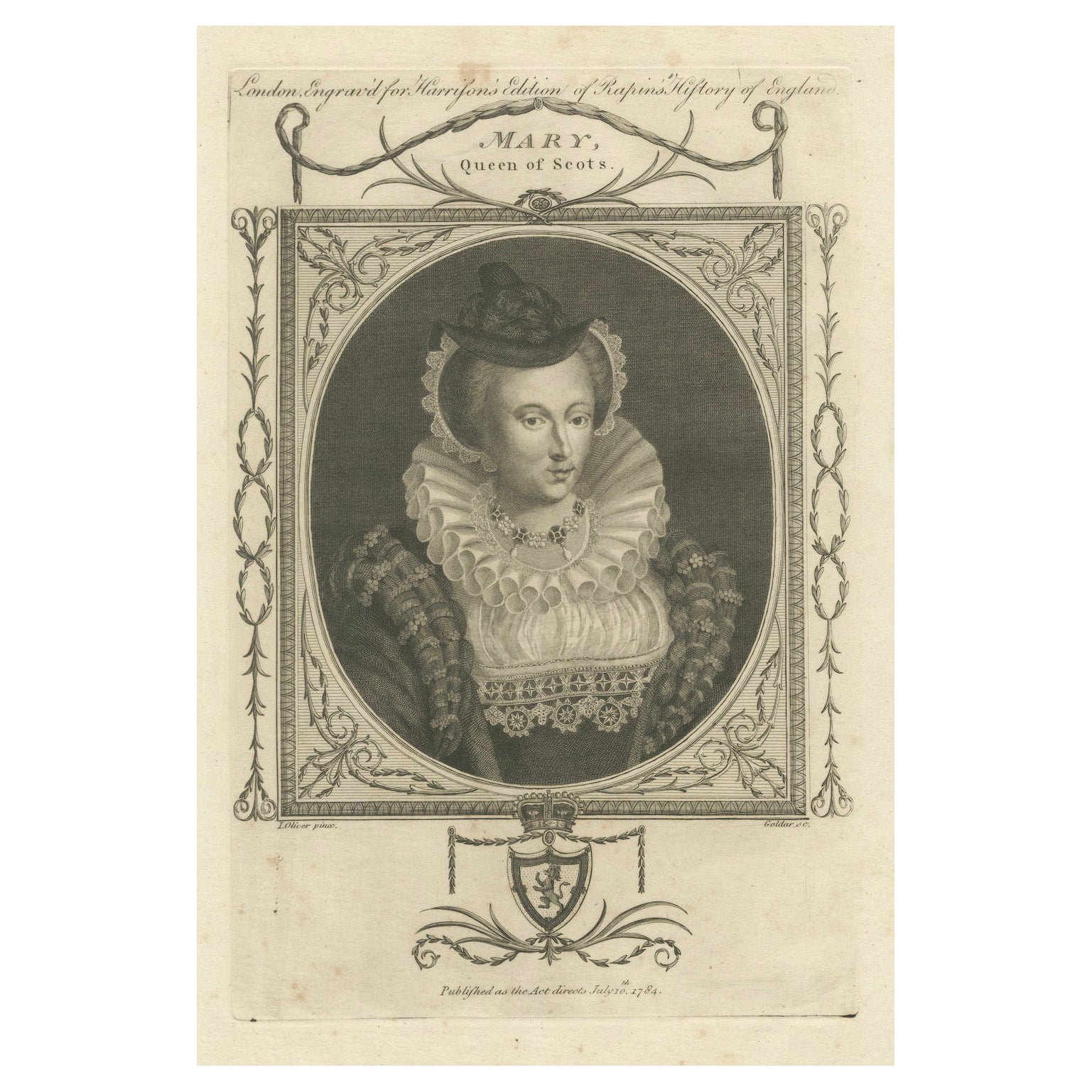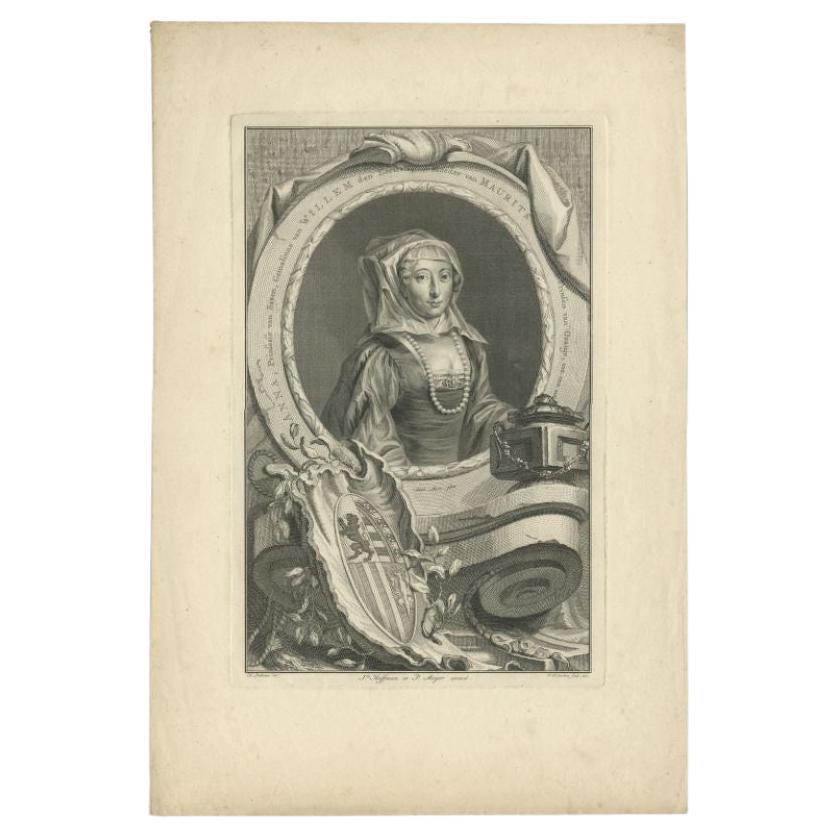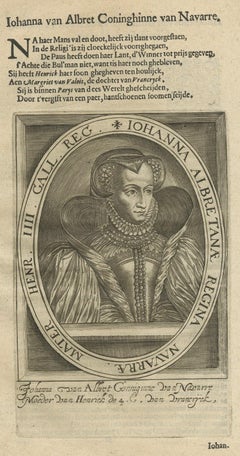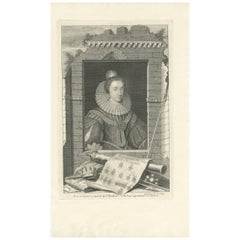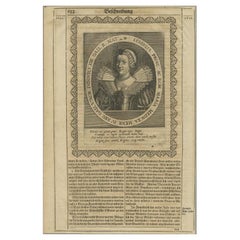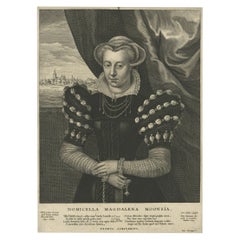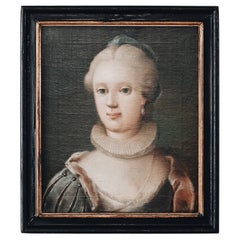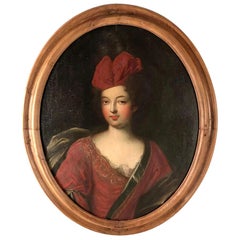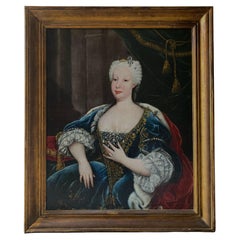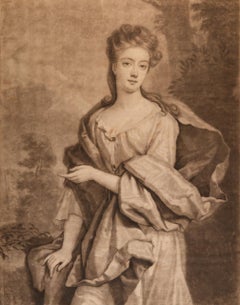Items Similar to Isabella Clara Eugenia, One of the Most Powerful Women in 16th and 17th-Century
Want more images or videos?
Request additional images or videos from the seller
1 of 6
Isabella Clara Eugenia, One of the Most Powerful Women in 16th and 17th-Century
$325.90
$407.3720% Off
£242.61
£303.2620% Off
€272
€34020% Off
CA$446.39
CA$557.9920% Off
A$496.49
A$620.6120% Off
CHF 259.25
CHF 324.0620% Off
MX$6,041.74
MX$7,552.1720% Off
NOK 3,311.03
NOK 4,138.7920% Off
SEK 3,105.16
SEK 3,881.4520% Off
DKK 2,070.64
DKK 2,588.3020% Off
Shipping
Retrieving quote...The 1stDibs Promise:
Authenticity Guarantee,
Money-Back Guarantee,
24-Hour Cancellation
About the Item
Antique portrait titled 'Isabella Clara Eugenia (..)'. Old portrait of Isabella Clara Eugenia. This print originates from 'Vaderlandsche historie, vervattende de geschiedenissen der nu Vereenigde Nederlanden, inzonderheid die van Holland (..)' by J. Wagenaar.
Artists and Engravers: Published by I. Tirion, Amsterdam.
Condition: Very good, please study image carefully.
Date: c.1750
Overall size: 14 x 23.5 cm.
Image size: 11 x 17 cm.
We sell original antique maps to collectors, historians, educators and interior decorators all over the world. Our collection includes a wide range of authentic antique maps from the 16th to the 20th centuries. Buying and collecting antique maps is a tradition that goes back hundreds of years. Antique maps have proved a richly rewarding investment over the past decade, thanks to a growing appreciation of their unique historical appeal. Today the decorative qualities of antique maps are widely recognized by interior designers who appreciate their beauty and design flexibility. Depending on the individual map, presentation, and context, a rare or antique map can be modern, traditional, abstract, figurative, serious or whimsical. We offer a wide range of authentic antique maps for any budget.
- Dimensions:Height: 9.26 in (23.5 cm)Width: 5.52 in (14 cm)Depth: 0 in (0.01 mm)
- Materials and Techniques:
- Period:
- Date of Manufacture:circa 1750
- Condition:Condition: Very good, please study image carefully.
- Seller Location:Langweer, NL
- Reference Number:Seller: BGI-003211stDibs: LU3054329258382
About the Seller
5.0
Recognized Seller
These prestigious sellers are industry leaders and represent the highest echelon for item quality and design.
Platinum Seller
Premium sellers with a 4.7+ rating and 24-hour response times
Established in 2009
1stDibs seller since 2017
2,510 sales on 1stDibs
Typical response time: <1 hour
- ShippingRetrieving quote...Shipping from: Langweer, Netherlands
- Return Policy
Authenticity Guarantee
In the unlikely event there’s an issue with an item’s authenticity, contact us within 1 year for a full refund. DetailsMoney-Back Guarantee
If your item is not as described, is damaged in transit, or does not arrive, contact us within 7 days for a full refund. Details24-Hour Cancellation
You have a 24-hour grace period in which to reconsider your purchase, with no questions asked.Vetted Professional Sellers
Our world-class sellers must adhere to strict standards for service and quality, maintaining the integrity of our listings.Price-Match Guarantee
If you find that a seller listed the same item for a lower price elsewhere, we’ll match it.Trusted Global Delivery
Our best-in-class carrier network provides specialized shipping options worldwide, including custom delivery.More From This Seller
View AllAntique Portrait of Joan of Navarre, Queen of England, 1615
Located in Langweer, NL
Antique portrait titled 'Iohanna Albretanae Regina (..)'. Portrait of Joan of Navarre. This print originates from 'Tooneel der keyseren ende coningen van christenryck sedert den onde...
Category
Antique 17th Century Prints
Materials
Paper
$230 Sale Price
20% Off
Antique Portrait of Elizabeth, Queen of Bohemia, by G. Vertue, circa 1750
By George Vertue
Located in Langweer, NL
Antique print titled 'Elisabeth Pr. Pal: Queen of Bohemia'. Elizabeth, Queen of Bohemia, 1596-1662. Daughter of James VI and I. Engraved by G. Vertue.
Category
Antique Mid-18th Century European Prints
Materials
Paper
Antique Portrait of Marie De Medici, circa 1660
Located in Langweer, NL
Antique portrait titled 'Sereniss Princ Ac Dom Maria Medicea (..)'. Portrait of Marie de Medici, Queen of France. Half length with widow's peak, open c...
Category
Antique 17th Century Prints
Materials
Paper
$153 Sale Price
20% Off
Rare Portrait of Magdalena Moon, Heroine of The Siege of Leiden in Holland, 1649
Located in Langweer, NL
Antique print, titled: 'Domicella Magdalena Moonsia'
Very rare half length portrait of Magdalena Moons. Magdalena Moonsia is known as the heroine of the city of Leiden (seen over...
Category
Antique 1640s Prints
Materials
Paper
$805 Sale Price
20% Off
1784 Engraved Elegance of Mary, Queen of Scots - Tragic Monarch
Located in Langweer, NL
This is an authentic engraved portrait of Mary, Queen of Scots.
Mary was one of the most fascinating and tragic figures in Scottish and English history. She became queen consort in...
Category
Antique 1780s Prints
Materials
Paper
Antique Portrait of Anna of Saxony, Wife of William of Orange, 1757
Located in Langweer, NL
Antique portrait titled 'ANNA, Prinsesse van Saxen, Gemalinne van WILLEM den Eersten, Moeder van MAURITS Prinsen van Oranje, enz. enz. enz'. Portrait of Anna of Saxony, wife of William of Orange...
Category
Antique 18th Century Dutch Prints
Materials
Paper
You May Also Like
18th Century Portrait
Located in Allerum, SE
Fine 18th century portrait of a lady, unsigned, circa 1750, Sweden.
(reframed, oil on canvas) According to old frame painted by Johan Horner (...
Category
Antique 18th Century Swedish Rococo Paintings
Materials
Canvas
$4,320 Sale Price
20% Off
Late 17th Century Oil Portrait of a Lady
Located in Lymington, GB
An oil on canvas portrait of a young French courtier, circa 1690.
This evocative antique French-school picture has been attributed to the portrait painter Jean-François de Troy (1679-1752).
De Troy was famous as a portrait painter of fashionable society women.
This is a very attractive late-17th century painting surviving in its original frame and stretcher. The canvas appears to be untouched.
References:
'Jean François de Troy, The Alarm, or the Gouvernante Fidèle', at the Victoria and Albert Museum, London.
'Jean François de Troy, Paris 1679 - Rome 1752', at the Thyssen-Bornemisza Museum.
Laurie G. Winters, Troy, de, Grove Art Online, Oxford Art Online, Oxford University Press, 6 May 2016.
Everett Fahy & Jayne Wrightsman...
Category
Antique 17th Century French Paintings
Materials
Canvas
Portrait of D. Maria Bárbara De Bragança, Circle of Louis-Michel Van Loo
By H. van Loon
Located in Lisboa, PT
PORTRAIT OF D. MARIA BÁRBARA DE BRAGANÇA (1711-1758), QUEEN OF SPAIN
Circle of Louis-Michel van Loo (1707-1771)
Oil on canvas
Her Royal Highness, the Infanta Maria Barbara of Braganza (1711-1758) was the first-born child of King John V of Portugal (1689-1750) and his queen consort Maria Anna of Austria (1683-1754). Born in December 1711, she had the Convent Palace of Mafra built in her honour following a vow made by her royal father. Her status as Princess of Brazil, inherent to 18th century Portuguese presumptive heirs, would however be superseded once the queen gave birth to two male princes, D. Pedro (1712-1714) and D. José (1714-1777), preventing her from ascending to the throne.
Daughter of one of the most illustrious monarchs of his time, Maria Barbara was carefully educated to become a fond admirer of the arts, and of music in particular, having had the Italian composer Domenico Scarlatti (1685-1757) as her music teacher.
On the 10th January 1723 the young princess was betrothed to the Infante Ferdinand of Spain (1713-1759), eldest son of King Philip V (1683-1746). Six years later, on the 19th January, she entered her new country in a carefully choreographed ceremony that became known to history as the “Exchange of the Princesses”. This unique event took place on a specially built Bridge-Palace, a wooden, luxuriously decorated structure that included various modules and rooms, on both banks of the river Caia, the natural border between the town of Elvas in Portugal and of Badajoz in Spain. Simultaneously, on the same day that the Portuguese Infanta crossed the border to marry the Spanish Crown Prince, her new sister in law, the Infanta Mariana Victoria of Bourbon (1718-1781), her husband’s sister, crossed the same bridge in the opposite direction to marry Prince D. José, the Portuguese heir to the throne.
Once married, Maria Barbara would spend 17 years as Princess of Asturias, only becoming Queen of Spain at her husband’s accession following the death of Philip V in 1746. She is portrayed in the 1743 painting by Louis-Michel van Loo (1707-1771) now in the Prado Museum, in which Philip V had himself represented with all his close family.
The new Queen would take an important role at court eventually becoming the liaison between her husband and the King of Portugal, particularly throughout the negotiations for the Treaty of Madrid (1746-1750). Maintaining her interest in music, she patronized the Italian castrato singer Farinelli (1705-1782) while remaining close to her old master Scarlatti, having herself composed some sonatas for a large orchestra. She would also commission and fund the building of the Royal Salesians Monastery complex in central Madrid, where both her and Ferdinand VI are buried.
The portrait we are presenting for sale shows the Queen in half-length, turning left at three quarters. She is wearing a blue low-cut dress embroidered with flowers and foliage, over a lace cuffed white blouse, and an ermine cloak pined on the left-hand side by a diamond broach. The powdered hair style is held sideways by a seven diamond and black plume headdress and topped by a small gold and pearl crown. The right arm rests on a cushion while the left hand, at chest height, holds a miniature male portrait.
The Infanta’s features are analogous to the 1725 portrait by the painter Domenico Duprà (1689-1770), also in the Prado Museum collection. Further similarities can be found in another portrait by Louis-Michel van Loo, in which a seven diamond and black plume headdress is also present. In this work, the cushion supporting Maria Barbara’s right arm has also some obvious similarities to our painting. The same diamond headdress reappears in Van Loo’s above-mentioned portrait of Philip V’s family dated from 1743.
It is nevertheless in Lisbon’s Ajuda National Palace that it is possible to find an almost identical depiction of the Infanta holding a miniature portrait of her husband. In it, the future Ferdinand VI is portrayed facing right at three quarters and wearing a curly wig, suit of armour, the golden fleece insignia and a blue band, in a composition that closely resembles an 18th century Spanish school painting that appeared in the art market in January 2016.
Another detail common to various portraits of the Portuguese Infanta and Queen of Spain is the small gold and pearl crown on her head. In another Van Loo painting, also from the Prado Museum, in which Maria Barbara is portrayed as Queen, this crown is represented together with a headdress similar to the one previously described. Another two paintings by the same artist, at the Royal Academy of Saint Ferdinand, include the same ornament.
We must also refer the paintings by the artist Jean Ranc (1674-1735). In one, dating from 1729 (Prado Museum), the Infanta is depicted outdoors holding a flower bouquet and wearing a yellow silk dress with red cloak, and a set of diamond and ruby jewellery that includes a headdress similar to the one present in our portrait. Another work by the same artist, belonging to the Complutence University of Madrid, depicts the Infanta sumptuously dressed in identical colours to our painting and wearing an elaborate headdress and diadem.
These portraits, beyond their iconographical importance as contemporary records of the Infanta and Queen Maria Barbara, are also illustrative of 18th century fashion for jewelled head dressing. Often, flowers were combined with joyful adornments, composing almost theatrical displays that would reinforce the ostentatious nature of the image. The ornamental flowers and the chromatic character of the jewels would complement the luxury of the colourful dresses in blue, crimson, green or other silk shades, in compositions whose sole purpose was to highlight a royal sitter’s wealth and power, becoming an essential statement accessory within the strict court protocols and codes of conduct.
Circle of Louis-Michel van Loo (1707-1771)
Slowly but steadily, the resolute, tranquil and dignified attitude of Renaissance and Baroque portraiture becomes artificial and presumptuous. Mid 18th century society favours elusive expression and psychological deepness, albeit limited to the face, that, with emphasis on detail, on the rich colour palette and on changing costumes and landscapes, associated to the courtliness of gestures, creates a strongly artificial environment while maintaining a highly poetic intrinsic character.
Louis-Michel van Loo followed a dynasty of famous Dutch origin artists that had settled in France. Initially taught by his father, Jean-Baptiste von Loo (1684-1745), the younger van Loo studied in Turin and Rome and frequented the Paris Academy. In Rome he worked with his uncle Charles-André van Loo (1705-1765) and become a painter for the Turin Court. In 1737 he arrived in Spain being summoned by Philip V to succeed Jean Ranc as painter of the king’s chamber.
In Madrid, his work covers the numerous Court commissions and the Royal Saint Ferdinand Fine Arts Academy, of which he was a founding member and director for the Painting department in 1752. Is production at court consisted essentially of numerous portrait paintings, often Royal gifts...
Category
Antique 18th Century Spanish Baroque Paintings
Materials
Canvas
The Duchess of St. Albans: A 17th C. Portrait After a Kneller Painting
By (After) Sir Godfrey Kneller
Located in Alamo, CA
This is a 17th century engraved mezzotint portrait of the Duchess of St. Albans by John Smith, after a painting by Sir Godfrey Kneller. It was published in London by John Boydell in 1694.
The Duchess of St. Albans (1642-1712) was a woman named Diana de Vere. She was born in 1642, the daughter of Aubrey de Vere, the 20th Earl of Oxford. In 1662, she married Charles Beauclerk, the illegitimate son of King Charles II and his mistress, Nell Gwyn. As a result of her marriage, Diana became the Duchess of St. Albans, and she and Charles had several children together. Diana was known for her beauty and charm, and she was a prominent figure in the court of King Charles II. Despite her husband's illegitimate birth, Diana was highly respected in the royal court and was known for her intelligence and wit. She was a patron of the arts and supported many artists and writers of the time. Diana lived through a tumultuous period of English history, including the Great Fire of London and the Glorious Revolution, which saw King James II replaced by William of Orange. She died in 1712 at the age of 70 and was buried in Westminster Abbey. Descendants of Diana and her husband, who was an illegitimate son of King Charles II, include Diana, Princess of Wales and her son William, Duke of Cambridge.
An author wrote of her: "The line of Vere, so long renown’d in arms,
Concludes with luster in St. Albans’s charms;
Her conquering eyes have made their race complete,
It rose in valor, and in beauty set."
This striking mezzotint engraving depicts Diana, Duchess of St Albans in a three-quarter length pose, standing, wearing loose flowing dress and a wrap. She has a very serene, calm appearance as she is looking straight at the viewer. There is a landscape of trees in the background. The print is adhered in the corners to an archival backing, which is itself adhered in the upper corners to a larger backing. The print is trimmed to just beyond the plate mark. There are areas of discoloration in the margins and in the inscription area, but the print is otherwise in very good condition. The sheet measures 14.5" high and 10" wide. This mezzotint is held by multiple museums and institutions, including The British Museum, The National Portrait Gallery London, The Fine Arts Museum of Boston, The Lewis Walpole Library at Yale, The Yale Center for British Art, The Fitzwilliam Museum at Cambridge and The National Galleries of Scotland. The original Kneller painting is part of the British Royal Collection Trust and hangs in the King's Private Dining Room at Hampton Court Palace.
Sir Godfrey Kneller (1646-1723) was a leading portrait painter of his time, particularly renowned for his depictions of the British aristocracy and royalty. He was born in Lübeck, Germany, and trained in Amsterdam under the painter Ferdinand Bol...
Category
Late 17th Century Portrait Prints
Materials
Mezzotint
Antique Portrait of a Famous Maiden
Located in Alessandria, Piemonte
O/5300 - Oval antique portrait of a young famous maiden, but critics questioned are undecided : is she The Duchess of Polignac or Madame de Warens? On the back of the picture someone writed "Madame de Warens in 1729", but this portrait is very similar to that of Yolande Martine Gabrielle de Polastron duchesse of Polignac, great friend and favorite of the queen Maria Antonietta...
Category
Antique Early 19th Century French Beaux Arts Paintings
Materials
Canvas
17th Century Spanish Oil on Canvas Depicting a Queen
Located in Los Angeles, CA
A 17th century Spanish oil painting on canvas depicting a queen witting on a throne with a crown on her head wearing an elaborate costume in brown Gray Red and Beige. She is wearing ...
Category
Antique 17th Century Spanish Paintings
Materials
Canvas
More Ways To Browse
American 4 Drawer Chest
Antique 6 Drawer Chest
Antique Camel Table
Antique Chest Federal
Antique Farm Cabinet
Antique French Bulldog
Antique Furniture Cheshire
Antique Kangaroo
Antique Mahogany 4 Drawer Chest
Antique Oak Bow Front Cabinet
Antique Pine China Cabinet
Antique Primitive Chest
Antique Rosewood Dresser
Antique Salvage Windows
Antique Seahorse
Antique Shell Bottles
Antique Silver New Orleans
Antique Spice Cabinet
